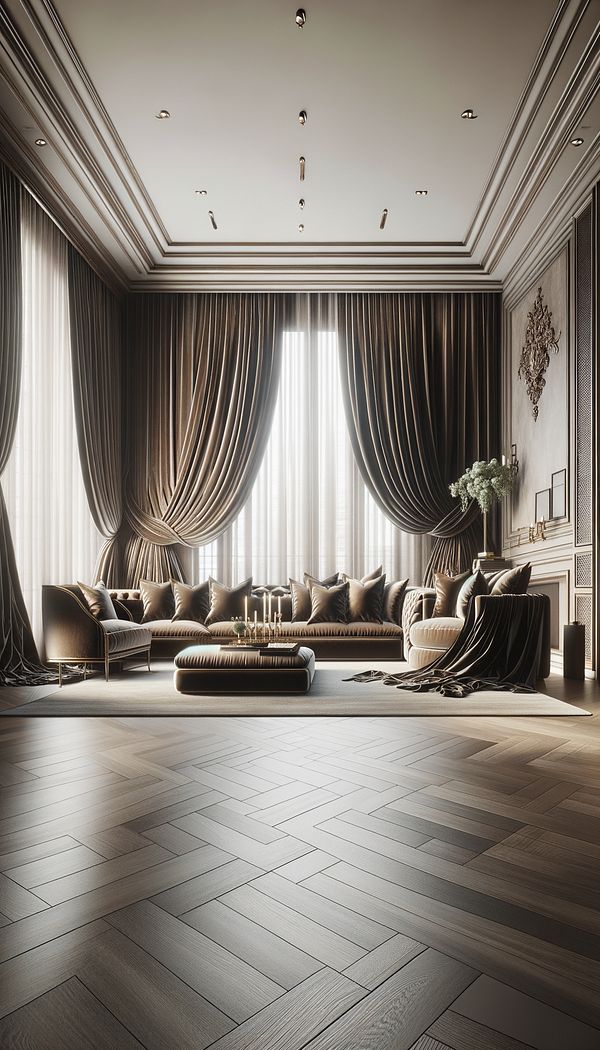What is Drapery?
Drapery refers to heavy curtains made of fabric, used to adorn or cover windows.
Description
Drapery, in the realm of interior design, encapsulates more than just the concept of heavy curtains. It represents an element of style, texture, and color that can substantially alter a room's ambiance and aesthetic appeal. Traditionally made from thick, luxurious fabrics such as silk, velvet, or heavy cotton, draperies serve both functional and decorative purposes. Functionally, they act as insulators and light blockers, enhancing privacy and comfort. Decoratively, they contribute depth, richness, and a layer of sophistication to the interior design of a space.
The art of choosing the right drapery involves considering various factors such as fabric type, color, pattern, and length. These elements work in harmony to complement the overall [design styles] and color and patterns of a room. Drapes can be hung in different styles - from classic pleated designs to contemporary grommet or tab-top options, providing versatility in aesthetic expression.
The importance of drapery in interior design extends beyond the living room or bedroom. They can be utilized in any space requiring visual enhancements or functionality improvements, including dining rooms, home offices, and even kitchens. With the advent of motorized curtain rods and customized design options, drapery continues to evolve, accommodating modern preferences and technological advancements without losing its timeless charm.
Usage
Drapery is commonly used in residential settings to provide privacy, control natural light, and add a decorative element to living rooms, bedrooms, and dining areas. In commercial spaces like hotels, theaters, and high-end restaurants, draperies enhance the elegance and sophistication of the interior. Custom-designed draperies are often employed in luxurious settings to match specific interior design themes or color schemes.
FAQs
-
Can drapery be used in modern interior design?
Yes, drapery can be seamlessly integrated into modern interior design. By selecting fabrics with minimal patterns, solid colors, or geometric designs and opting for streamlined hanging styles like grommet or tab-top, draperies can complement and enhance modern spaces.
-
How does one select the right drapery fabric?
Selecting the right drapery fabric involves considering the room's function, the desired effect (e.g., light filtering or blackout), and the room's overall design style. Fabrics like velvet or silk add luxury, while linen or cotton provide a more casual look.
-
Are there different ways to hang draperies?
Yes, draperies can be hung in various styles, such as pleated, grommet, tab-top, or rod pocket. Each style offers a different aesthetic and can influence the room's overall appearance.
Practical Application
When incorporating drapery into an interior design, consider the room's existing color scheme and style. Choose a fabric that complements these elements. Remember, the length and hanging style of the drapery can significantly affect the room's visual height and elegance. For high ceilings, floor-to-ceiling drapes can create a sense of grandeur, while for smaller spaces, avoiding overly heavy fabrics can help maintain a balanced look.
-
Design Styles478 articles
-
Window Treatments65 articles
-
Decorating Principles & Elements330 articles
-
Materials & Textiles360 articles
-
Color & Patterns154 articles
-
QuatrefoilA quatrefoil is a decorative element consisting of a symmetrical shape which forms the overall outline of four partially overlapping circles of the same diameter.
-
Unfinished FurnitureUnfinished furniture is furniture that has been constructed but has not had its final finish applied.
-
Sleeper SofaA sofa that converts into a bed.
-
Accent PieceAn accent piece is an item within an interior space that stands out due to its color, shape, texture, or unique design.
-
SoftwoodSoftwood is wood derived from coniferous trees.
